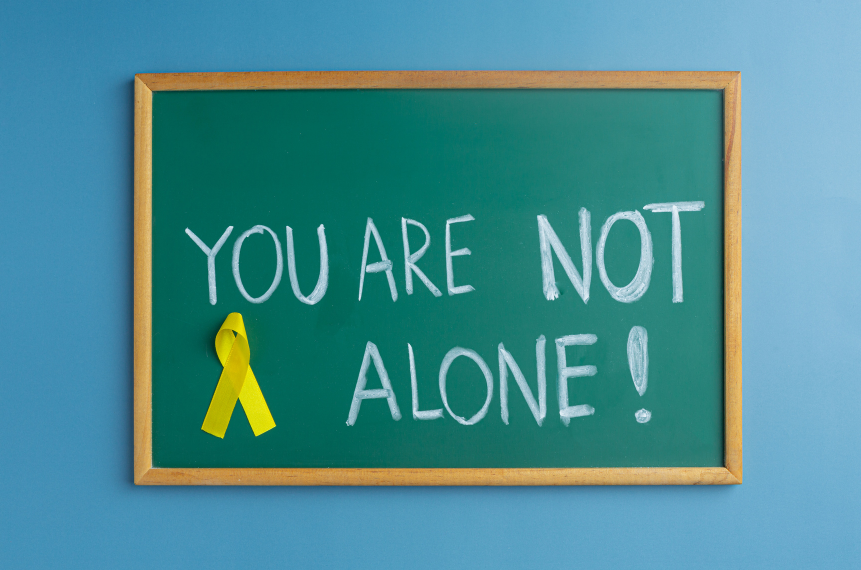Suicide – information and resources
August 31, 2022
According to the World Health Organization (https://www.who.int/news-room/fact-sheets/detail/suicide), more than 700,000 people die from suicide yearly around the world. In Canada, the average is 11 deaths per day. Suicide effects all races, all incomes, all ages, and all genders.
While the link between suicide and mental disorders (in particular, depression and alcohol use disorders) is well established in high-income countries, many suicides happen impulsively in moments of crisis with a breakdown in the ability to deal with life stresses, such as financial problems, relationship break-up or chronic pain and illness. (who.int)

In addition, experiencing conflict, disaster, violence, abuse, or loss and a sense of isolation are strongly associated with suicidal behaviour. Suicide rates are also high amongst vulnerable groups who experience discrimination, such as refugees and migrants; indigenous peoples; lesbian, gay, bisexual, transgender, intersex (LGBTI) persons; and prisoners. By far the strongest risk factor for suicide is a previous suicide attempt. (who.int)
But suicide IS preventable. The WHO lists some evidence-based interventions:
- limit access to the means of suicide (e.g. pesticides, firearms, certain medications);
- interact with the media for responsible reporting of suicide;
- foster socio-emotional life skills in adolescents;
- early identify, assess, manage and follow up anyone who is affected by suicidal behaviours.
Suicide prevention efforts require coordination and collaboration among multiple sectors of society, including the health sector and others such as education, labour, agriculture, business, justice, law, defence, politics, and the media. These efforts must be comprehensive and integrated as no single approach alone can make an impact on an issue as complex as suicide. (who.int)

Who to call when you or someone you know needs immediate help:
- 911
- Saskatoon Mobile Crisis, available 24 hours: 306-933-6200
- Talk Suicide Canada, available 24 hours: 1-833-456-4566 (toll-free)
- Residents of/de Québec 1-866-277-3553 (toll-free/sans frais), available/disponible 24 hrs
- For Indigenous peoples, Hope for Wellness Help Line: 1-855-242-3310 (toll-free) or connect to the online Hope for Wellness chat. Available 24 hours.
- For youth and young adults: Kids Help Phone. 1-800-668-6868 (toll-free) or text CONNECT to 686868. Available 24 hours.
The Government of Canada and the Canadian Mental Health Association – Saskatchewan list some possible warning signs of suicide on their websites.

Warning signs that might suggest someone is at risk of suicide include:
- thinking or talking about suicide
- having a plan for suicide
- withdrawal from family, friends or activities
- feeling like you have no purpose in life or reason for living
- increasing substance use, like drugs, alcohol and inhalants
- feeling trapped or that there’s no other way out of a situation
- feeling hopeless about the future or feeling like life will never get better
- talking about being a burden to someone or about being in unbearable pain
- anxiety or significant mood changes, such as anger, sadness or helplessness
- Recklessness: engaging in risky or harmful activities normally avoided
Suggestions for helping someone in crisis:
- listening and showing concern
- showing concern can be an immediate way to help someone
- listening won’t increase the risk of suicide and it may save a life
- find a private place and let your loved one take as much time as they need
- take your loved one seriously and listen without judgement—their feelings are very real
- keep your word—don’t make promises you can’t keep or don’t intend to keep
- tell your loved one that they are important and that you care about them
- talking with them and reassuring them that they’re not alone
- connecting them with a:
- crisis line
- counsellor
- trusted person (neighbour, friend, family member or Elder)
Resources for health-care professionals:
- Columbia Suicide Severity Rating Scale Screener (PDF)
- Mental Health Commission of Canada: Online suicide prevention training modules
- World Health Organization: Preventing Suicide – a resource for counsellors (PDF)
Government of Canada links:
- Preventing Suicide https://www.canada.ca/en/public-health/services/suicide-prevention.html
- Mental Health Support: Get Help https://www.canada.ca/en/public-health/services/mental-health-services/mental-health-get-help.html
- About Suicide https://www.canada.ca/en/public-health/services/suicide-prevention/about-suicide.html
Canadian Mental Health Association – Saskatchewan link:
- Preventing suicide: https://sk.cmha.ca/documents/preventing-suicide/
World Health Organization links:
- Suicide facts and information: https://www.who.int/news-room/fact-sheets/detail/suicide
- Suicide prevention fact sheets and videos: https://www.who.int/health-topics/suicide#tab=tab_1
Sources
- Government of Canada: https://www.canada.ca/en/public-health/services/suicide-prevention.html
- Canadian Mental Health Association – Saskatchewan: https://sk.cmha.ca/documents/preventing-suicide/
- World Health Organization: https://www.who.int/news-room/fact-sheets/detail/suicide
